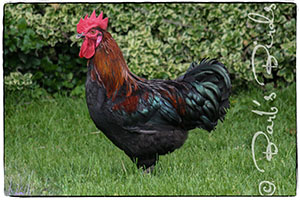

Always with an 's' on the end, they have their beginnings in the swampy rural area near Marans, on the Atlantic coast of France. This Mediterranean breed got its start when English sailors from the 12th, 13th, and 14th Centuries introduced their surviving gamecocks to the local hens of the area including the feather legged, "turkey headed", pea combed, Cocou de Malines and clean legged Cocou de Rennes. Later on, during the second half of the 19th Century, Langshans and Brahmas, large feather legged Asiatic breeds, were also introduced into the mix and the Marans started to take shape as a breed.
Marans today are large (cock 3.5 to 4 Kg, hen 2.6 to 3.2 Kg), prized for their dark brown eggs and succulent meat, feather-legged, a single comb, and white or slate (not yellow) legs, although the Standard in England calls for a clean legged bird.
The breed was founded for their large, dark reddish-brown eggs, the darkest brown-red eggs of any breed of chicken. The dark colour of the egg, passed on to the females by the cock, is painted on as a finish. This pigment is supplied by mucous glands located in the final 10 centimetres of the oviduct. The longer the egg remains in the hen, the more pigment that is applied and the darker the colour, therefore, Marans are not known for their egg production numbers. The final colour may be smooth, stippled, or spotted depending on how the colour is deposited as the egg moves through the oviduct. This process does not occur with ordinary brown eggs where the brown colour is built into the shell calcium, or the blue egg of the Araucana or Ameraucana, that is tinted throughout the thickness of the shell. The Marans dark brown colour can be washed off.
Marans egg colour fades throughout their laying cycle so what can start out dark can end up light and those light eggs might be hiding some dark eggs down the road if they were laid at the end of their laying cycle.
The breed was first recognized in France in 1929. Early colour varieties included Silver and Gold Cuckoos, and White and Black Copper-neck. Marans started to decline in the mid to late 1930s but enjoyed a substantial comeback in the 1950s. However, that comeback was not without problems. Egg production was given priority over egg colour and the introduction of some Russian hens to provide size also came at the expense of egg, and shank colour. The vagueness of the Standard, particularly as it applied to plumage of the black copper-necked Marans also represented a substantial handicap in the production of birds for exhibition.
Marans were first recognized by the American Poultry Association in 2011, adhering to the standards laid out in France. The first variety to be accepted in North America were the Black Coppers ("Brown-red" in France) variety. Wheaten Marans gained acceptance in North America the same year at Crossroads in Indiana in October. The "Blue-red" (Blue Copper) Marans variety was recognized in France in February of 2011. White Marans were accepted into the standard in North America in 2013.
Black Copper Marans are not straightforward birds to work with from a breeder’s perspective. The male birds are prone to comb issues (floppy, sprigs, carnation) and the females are often over-melanized which means the copper is completely hidden. The feathered shanks are also a pernicious issue. The Standard calls for lightly feathered legs - feathers that run down the outside edge of the shank and outside toe. There are to be no feathers on the middle toe as is the case with Langshans or Cochins. Egg colour is often an issue in some of the other Marans colour varieties.


| copyright (images and text) Barbara Dodington 2012, 2013, 2014, 2015, 2016, 2017, 2018, 2019, 2020, 2021, 2022 |
revised January 5, 2022 by Barbara Dodington |